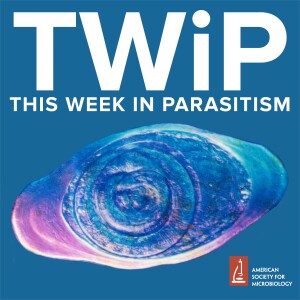
The TWiP team solves the case of the Woman Who Vomited Up a Worm, and discuss how malaria transmission intensity can modify the effectiveness of the RTS, S/AS01 vaccine in Africa.
Hosts: Vincent Racaniello, Dickson Despommier, Daniel Griffin, and Christina Naula
Subscribe (free): Apple Podcasts, Google Podcasts, RSS, email
Links for this episode- Malaria intensity modifies vaccine effectiveness (J Inf Dis)
- Letters read on TWiP 208
Become a patron of TWiP
Case Study for TWiP 208
An adult female resident of Hawai’i presented to the emergency department (ED) with several days of fever, abdominal pain, urinary hesitancy, and generalized itchiness. white blood cell [WBC] count 14,000 cells/mL) without eosinophilia. Urinalysis suggested a urinary tract infection and she was treated for acute UTI and discharged home.
The following day she returned to the ED because of worsening abdominal pain, bilateral hip and leg pain, dizziness, diffuse hyperesthesia, and allodynia (Pain from stimuli which are not normally painful) (worse on her feet and legs.) Urine culture from her initial ED visit grew normal urogenital flora. Her leukocytosis increased and she now had eosinophilia (WBC count 15,500 cells/mL; absolute eosinophil count 574). Laboratory evaluation was otherwise unremarkable. CT scans of the brain, abdomen, and pelvis were normal.
She was hospitalized and her allodynia worsened despite treatment with analgesics. She also developed a sensation of “electric eels swimming through [her] body. Electromyography and nerve conduction studies were normal. The patient underwent a lumbar puncture and CSF examination was notable for eosinophilic meningitis with 138 WBCs and 13% eosinophils (absolute eosinophil count 18).
Send your case diagnosis, questions and comments to twip@microbe.tv
Music by Ronald Jenkees
More Episodes
 2019-02-16
2019-02-16
 2019-01-26
2019-01-26
 2019-01-12
2019-01-12
 2018-12-29
2018-12-29
 2018-11-21
2018-11-21
 2018-11-10
2018-11-10
 2018-10-10
2018-10-10
 2018-09-28
2018-09-28
 2018-09-14
2018-09-14
 2018-07-24
2018-07-24
 2018-06-27
2018-06-27
 2018-06-13
2018-06-13
 2018-05-26
2018-05-26
 2018-05-02
2018-05-02
 2018-04-19
2018-04-19
 2018-03-22
2018-03-22
 2018-03-07
2018-03-07
Create your
podcast in
minutes
- Full-featured podcast site
- Unlimited storage and bandwidth
- Comprehensive podcast stats
- Distribute to Apple Podcasts, Spotify, and more
- Make money with your podcast
It is Free
- Privacy Policy
- Cookie Policy
- Terms of Use
- Consent Preferences
- Copyright © 2015-2024 Podbean.com





